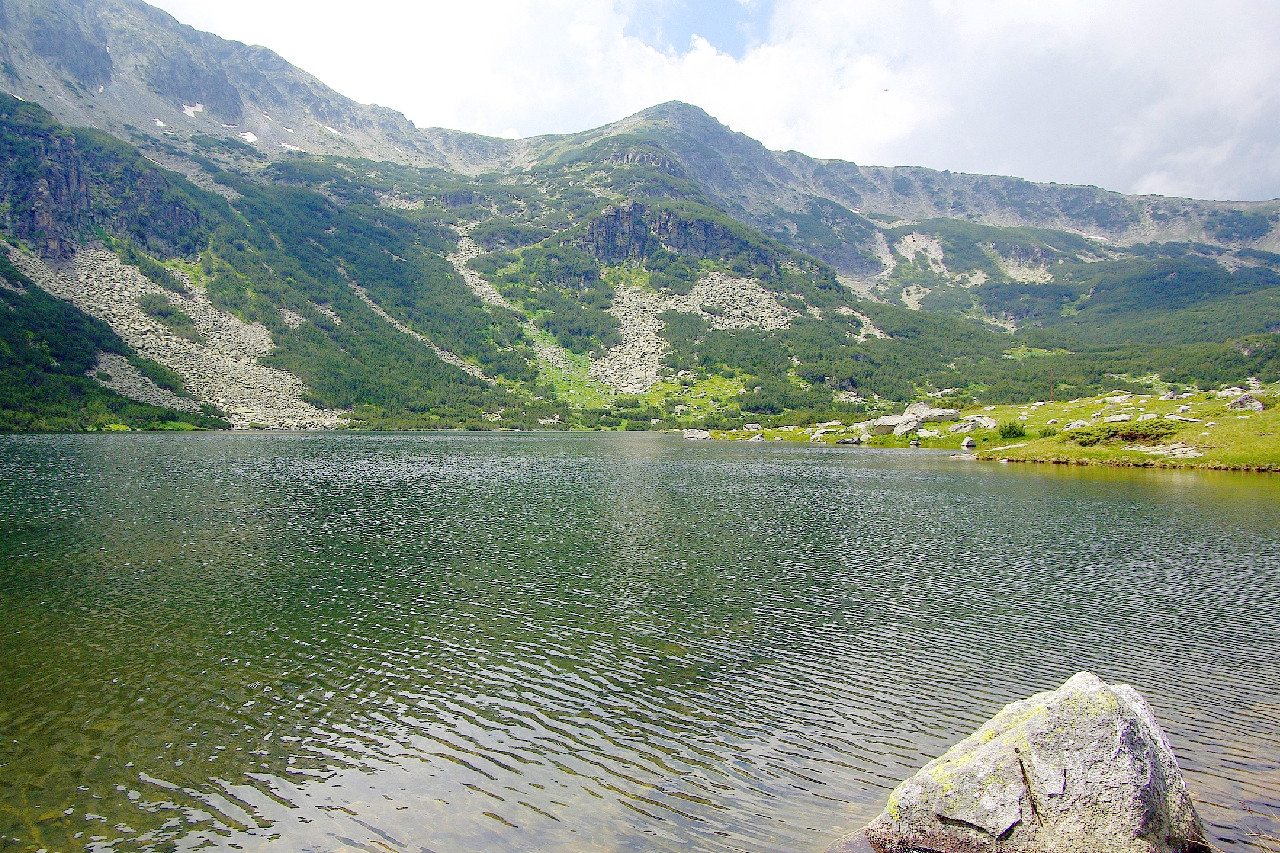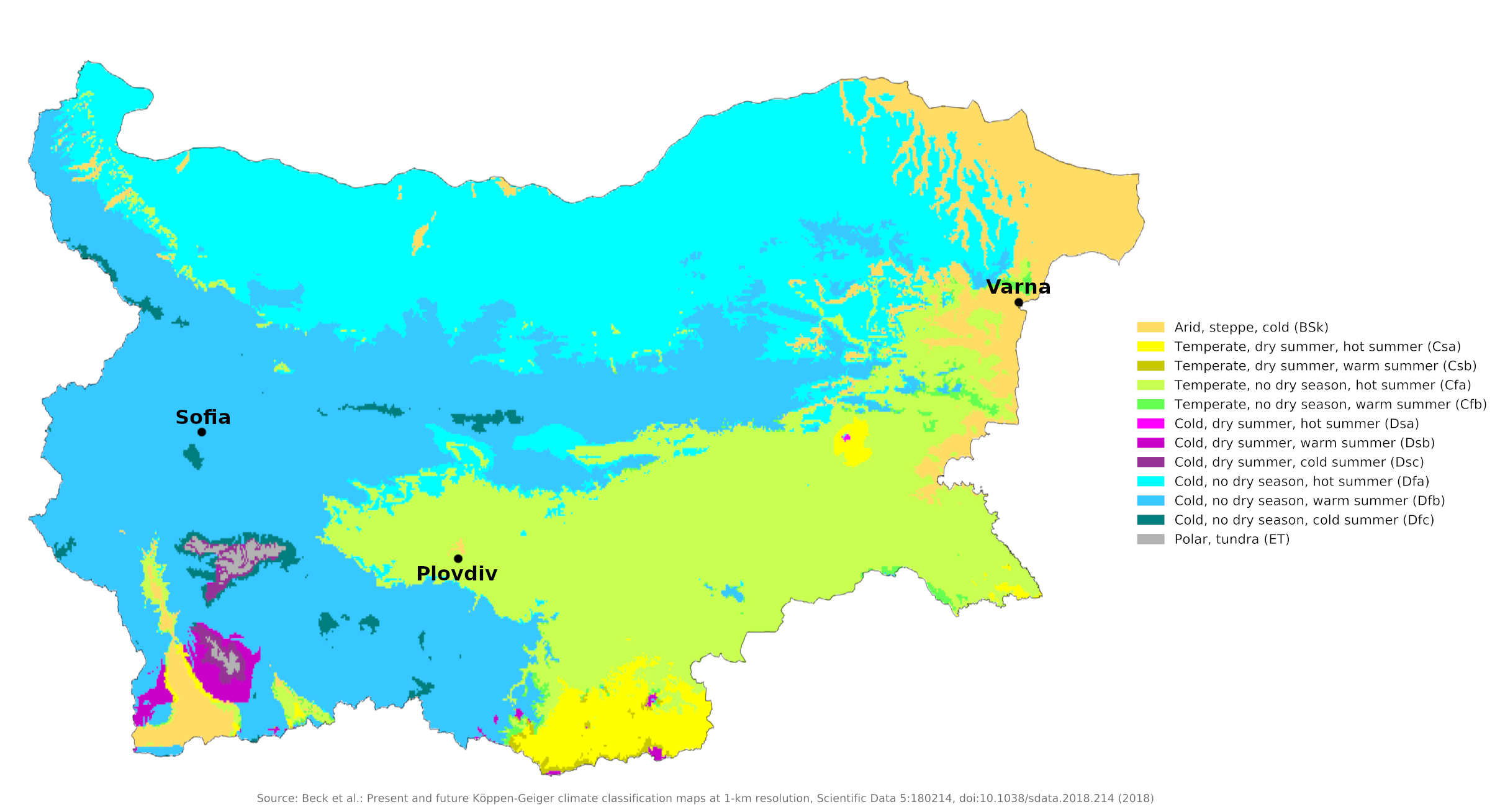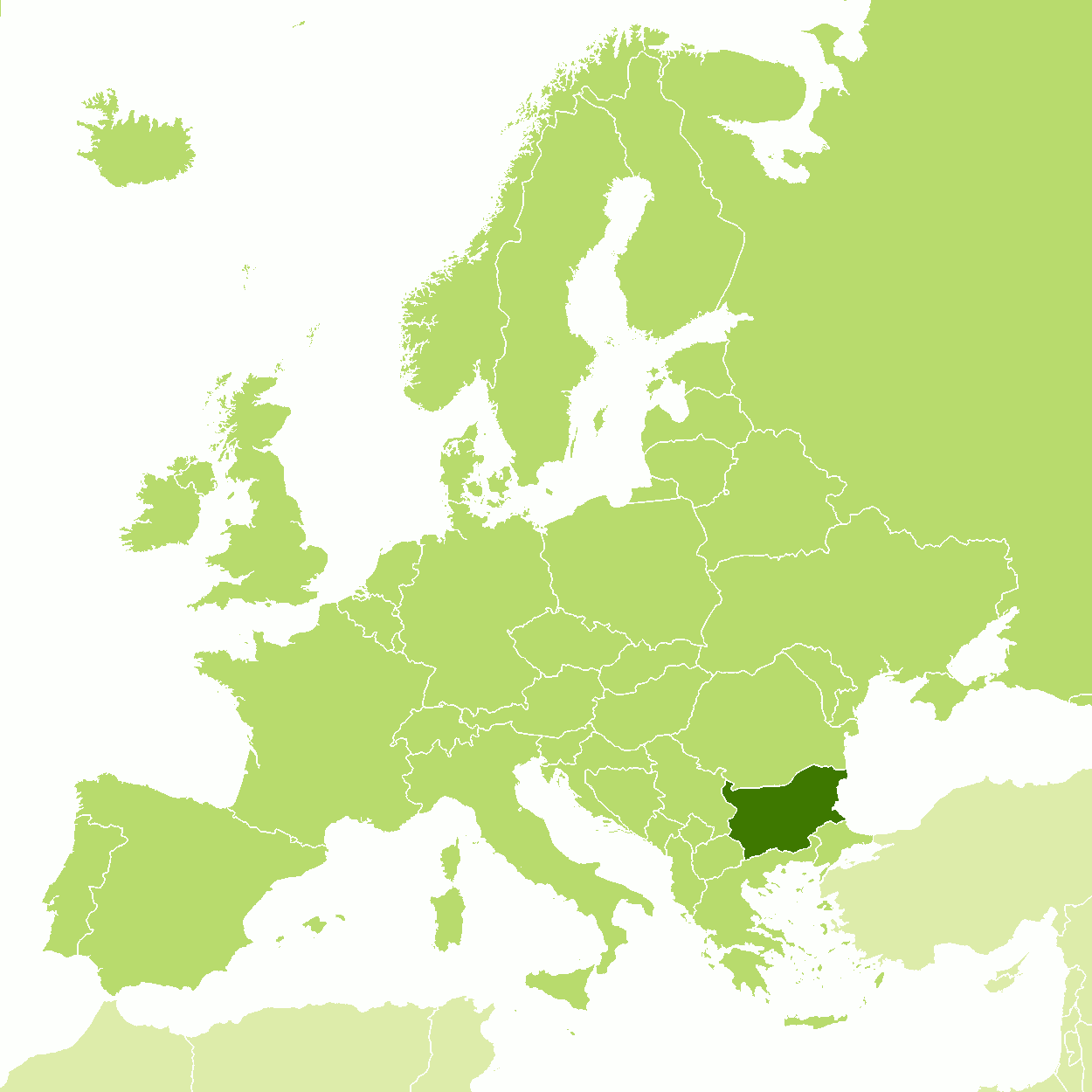The Climate of
Bulgaria
 Pirin National Park
Pirin National Park
Climate Map
 Climate map of Bulgaria
Climate map of Bulgaria
What is the climate of Bulgaria like?
Bulgaria is located in south-eastern Europe, where the climate is in transition between that of the Mediterranean and that of the plains of southern Russia. It has a coastline on the Black Sea and to the north the Danube forms the border with Romania. The western and southern borders with Serbia, North Macedonia and Greece traverse mountainous land rising between 1,800 and 2,750 meters (6,000–9,000 feet).
Considering its small area, Bulgaria has an unusually variable and complex climate. The country lies between the strongly contrasting continental and Mediterranean climatic zones. Bulgarian mountains and valleys act as barriers or channels for air masses, causing sharp contrasts in weather over relatively short distances. Because it is a transitional area, average temperatures and precipitation are erratic and may vary widely from year to year.
The largest lowland areas are along the coast and in the valley of the Maritsa River in the center of the country. Here the summers are warm and occasionally quite hot while the winters are quite cold. Precipitation is moderate and well distributed throughout the year with a slight summer maximum. On the coast (e.g. around the city of Varna), winters are slightly warmer, but even here bitterly cold weather can occur when winds blow from the northeast and carry cold air from Russia. During such cold spells, the Danube and other rivers can freeze over. Hot spells in summer are associated with winds from the northeast and southeast. The total number of rainy days is not large across the country, but it snows frequently in winter and even occasionally in spring.
The Southeast has a comparatively warm climate; Spring begins six weeks earlier than elsewhere in Bulgaria and the vegetation is that of southern Europe. During calm summer weather periods, conditions on the Black Sea coast can resemble those on the Mediterranean and a number of summer resorts have developed in this area. However, such fine periods of heat can be interrupted by thunderstorms with hail and heavy rain. During the winter strong winds and violent local storms are frequent near the coast.
| Climate data for Varna (1961-1990) | |||||||||||||
|---|---|---|---|---|---|---|---|---|---|---|---|---|---|
| Month | Jan | Feb | Mar | Apr | May | Jun | Jul | Aug | Sep | Oct | Nov | Dec | Year |
| Average high °C (°F) | 5.5 (41.9) | 6.5 (43.7) | 9.6 (49.3) | 14.8 (58.6) | 20.1 (68.2) | 24.8 (76.6) | 27.1 (80.8) | 27.3 (81.1) | 23.8 (74.8) | 18.4 (65.1) | 13.1 (55.6) | 8.1 (46.6) | 16.6 (61.9) |
| Daily mean °C (°F) | 2.2 (36.0) | 3.3 (37.9) | 6.0 (42.8) | 11.0 (51.8) | 16.0 (60.8) | 20.3 (68.5) | 22.5 (72.5) | 22.5 (72.5) | 19.1 (66.4) | 14.1 (57.4) | 9.3 (48.7) | 4.9 (40.8) | 12.6 (54.7) |
| Average low °C (°F) | −1.1 (30.0) | 0.0 (32.0) | 2.4 (36.3) | 7.1 (44.8) | 11.8 (53.2) | 15.7 (60.3) | 17.8 (64.0) | 17.6 (63.7) | 14.4 (57.9) | 9.8 (49.6) | 5.5 (41.9) | 1.6 (34.9) | 8.6 (47.4) |
| Average precipitation mm (inches) | 38 (1.5) | 41 (1.6) | 34 (1.3) | 44 (1.7) | 40 (1.6) | 46 (1.8) | 37 (1.5) | 32 (1.3) | 31 (1.2) | 36 (1.4) | 50 (2.0) | 45 (1.8) | 474 (18.7) |
| Source: World Meterological Organization | |||||||||||||
| Climate data for Plovdiv (1952–2000) | |||||||||||||
|---|---|---|---|---|---|---|---|---|---|---|---|---|---|
| Month | Jan | Feb | Mar | Apr | May | Jun | Jul | Aug | Sep | Oct | Nov | Dec | Year |
| Average high °C (°F) | 5.2 (41.4) | 8.3 (46.9) | 13.0 (55.4) | 18.4 (65.1) | 23.7 (74.7) | 28.0 (82.4) | 30.7 (87.3) | 30.3 (86.5) | 26.0 (78.8) | 19.4 (66.9) | 11.9 (53.4) | 6.4 (43.5) | 18.5 (65.3) |
| Daily mean °C (°F) | 0.9 (33.6) | 3.2 (37.8) | 7.2 (45.0) | 12.3 (54.1) | 17.3 (63.1) | 21.5 (70.7) | 23.9 (75.0) | 23.2 (73.8) | 19.0 (66.2) | 13.1 (55.6) | 6.9 (44.4) | 2.3 (36.1) | 12.7 (54.9) |
| Average low °C (°F) | −3.0 (26.6) | −1.4 (29.5) | 1.8 (35.2) | 6.2 (43.2) | 11.0 (51.8) | 15.0 (59.0) | 17.0 (62.6) | 16.5 (61.7) | 12.6 (54.7) | 7.6 (45.7) | 2.6 (36.7) | −1.3 (29.7) | 7.1 (44.8) |
| Average precipitation mm (inches) | 27 (1.1) | 34 (1.3) | 37 (1.5) | 41 (1.6) | 77 (3.0) | 57 (2.2) | 39 (1.5) | 43 (1.7) | 35 (1.4) | 37 (1.5) | 36 (1.4) | 39 (1.5) | 502 (19.8) |
| Source: Climatebase.ru | |||||||||||||
In the higher parts of the country (e.g. around the capital Sofia), winters are colder and summers are pleasant and fresh. Sofia is generally covered in snow during the winter months; however, it enjoys a somewhat more even summer climate. The altitude tends to moderate summer temperature and relieve oppressive high humidity. The air is refreshing and the summer nights are cool and fresh.
| Climate data for Sofia (1991–2020) | |||||||||||||
|---|---|---|---|---|---|---|---|---|---|---|---|---|---|
| Month | Jan | Feb | Mar | Apr | May | Jun | Jul | Aug | Sep | Oct | Nov | Dec | Year |
| Average high °C (°F) | 3.6 (38.5) | 6.5 (43.7) | 11.5 (52.7) | 16.7 (62.1) | 21.4 (70.5) | 25.3 (77.5) | 27.9 (82.2) | 28.4 (83.1) | 23.3 (73.9) | 17.6 (63.7) | 10.7 (51.3) | 4.6 (40.3) | 16.5 (61.6) |
| Daily mean °C (°F) | −0.5 (31.1) | 1.6 (34.9) | 5.8 (42.4) | 10.8 (51.4) | 15.5 (59.9) | 19.3 (66.7) | 21.5 (70.7) | 21.5 (70.7) | 16.8 (62.2) | 11.4 (52.5) | 5.9 (42.6) | 0.8 (33.4) | 10.9 (51.5) |
| Average low °C (°F) | −3.8 (25.2) | −2.3 (27.9) | 1.1 (34.0) | 5.4 (41.7) | 9.9 (49.8) | 13.4 (56.1) | 15.3 (59.5) | 15.3 (59.5) | 11.1 (52.0) | 6.7 (44.1) | 2.2 (36.0) | −2.3 (27.9) | 6.0 (42.8) |
| Average precipitation mm (inches) | 35.9 (1.41) | 35.5 (1.40) | 45.3 (1.78) | 52.3 (2.06) | 73.1 (2.88) | 81.6 (3.21) | 64.7 (2.55) | 53.1 (2.09) | 52.3 (2.06) | 53.9 (2.12) | 38.1 (1.50) | 39.9 (1.57) | 625.7 (24.63) |
| Average snowfall cm (inches) | 24.5 (9.6) | 20.6 (8.1) | 14.8 (5.8) | 3.1 (1.2) | 0 (0) | 0 (0) | 0 (0) | 0 (0) | 0 (0) | 1.5 (0.6) | 10.4 (4.1) | 20.7 (8.1) | 95.6 (37.5) |
| Source: NOAA | |||||||||||||
In general, the Bulgarian winter is short and severe; the spring short, changeable and rainy; the summer hot but tempered by thunderstorms; the autumn is wonderfully fine and sometimes extends into the month of December. Although the climate is generally temperate and pleasant, the variability throughout the year means that it can sometimes be uncomfortably cold in winter and rather warm and muggy in summer. Spring can be a very changeable season with rapid changes between warm and cold days. Daily hours of sunshine range from about two in January to ten in midsummer.
Rain falls fairly regularly throughout the year. Average precipitation in Bulgaria is about 650 millimeters (25 inches) per year. Dobruja in the northeast, the Black Sea coastal area, and parts of the Thracian Plain usually receive less than 500 millimeters (20 inches). The remainder of the Thracian Plain and the Danubian Plateau get less than the country average; the Thracian Plain is often subject to summer droughts. In the mountains precipitation can exceed 1,500 millimeters (60 inches), or even reach 2,500 millimeters (100 inches).
References
- E. A. Pearce, Charles Gordon Smith, (1990) The Hutchinson World Weather Guide, John Murray Press. ISBN 1859863426
- Timothy L. Gall, (ed.), (2003), Worldmark Encyclopedia of the Nations, Eleventh Edition, Thomson Gale
- Federal Research Division, Library of Congress, (1994), Bulgaria: a country study. Claitor's Pub. Division. ISBN 0844407518
- Hugh Chisholm, (ed.), (1911), Encyclopædia Britannica, Eleventh edition, Cambridge University Press
The Climate of
Bulgaria

In summary:
Overall, Bulgaria’s climate is temperate, with cold winters and hot summers. There is, however, a modified Mediterranean climate in the southern plains, because of the protection offered by the Balkan Mountains.